
Abbott and Costello Meet Frankenstein is a 1948 American horror comedy film directed by Charles Barton. The film features Count Dracula who has become partners with Dr. Sandra Mornay, as Dracula requires a "simple, pliable" brain to reactivate Frankenstein's monster. Dracula discovers that the "ideal" brain belongs to Wilbur Grey who is wooed by Mornay to the operating table, despite the warnings of Lawrence Talbot.

William Alexander "Bud" Abbott was an American comedian, actor and producer. He was best known as the straight man half of the comedy duo Abbott and Costello.

Abbott and Costello were an American comedy duo composed of comedians Bud Abbott and Lou Costello, whose work in radio, film, and television made them the most popular comedy team of the 1940s and 1950s, and the highest-paid entertainers in the world during the Second World War. Their patter routine "Who's on First?" is considered one of the greatest comedy routines of all time, a version of which appears in their 1945 film The Naughty Nineties.

Africa Screams is a 1949 American adventure comedy film starring Abbott and Costello and directed by Charles Barton that parodies the safari genre. The title is a play on the title of the 1930 documentary Africa Speaks! The supporting cast features Clyde Beatty, Frank Buck, Hillary Brooke, Max Baer, Buddy Baer, Shemp Howard and Joe Besser. The film entered the public domain in 1977.

Buck Privates is a 1941 musical military comedy film that turned Bud Abbott and Lou Costello into bona fide movie stars. It was the first service comedy based on the peacetime draft of 1940. The comedy team made two more service comedies before the United States entered the war. A sequel to this movie, Buck Privates Come Home, was released in 1947. Buck Privates is one of three Abbott and Costello films featuring The Andrews Sisters, who were also under contract to Universal Pictures at the time.
One Night in the Tropics is a 1940 comedy film which was the film debut of Abbott and Costello. They are listed as supporting actors but have major exposure with five of their classic routines, including an abbreviated version of "Who's on First?" Their work earned them a two-picture deal with Universal, and their next film, Buck Privates, made them bona fide stars. Songs in the film were by Jerome Kern with lyrics by Dorothy Fields.

Hit the Ice is a 1943 film starring the comedy team of Abbott and Costello and their first film directed by Charles Lamont. Lamont later directed the team's last few films in the 1950s.

In the Navy is a 1941 film starring the comedy team of Abbott and Costello. It was the second service comedy based on the peacetime draft of 1940. The comedy team appeared in two other service comedies in 1941, before the United States entered the war: Buck Privates released in January and Keep 'Em Flying released in November.

Hold That Ghost is a 1941 horror comedy film starring the comedy team of Abbott and Costello and featuring Joan Davis, Evelyn Ankers and Richard Carlson.
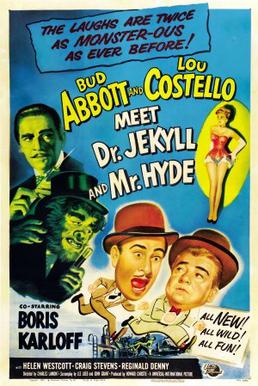
Abbott and Costello Meet Dr. Jekyll and Mr. Hyde is a 1953 American horror comedy film starring the comedy team of Abbott and Costello, co-starring Boris Karloff, and directed by Charles Lamont.
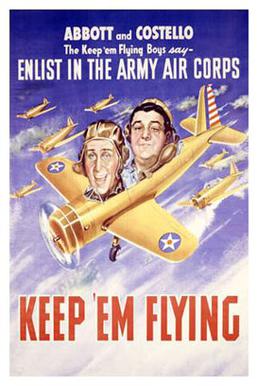
Keep 'Em Flying is a 1941 film starring the comedy team of Abbott and Costello. The film was their third service comedy based on the peacetime draft of 1940. The comedy team had appeared in two previous service comedies in 1941, before the United States entered the war: Buck Privates, released in January, and In the Navy, released in May. Flying Cadets, along with Keep 'Em Flying were both produced by Universal Pictures in 1941.

Rio Rita is a 1942 American comedy film directed by S. Sylvan Simon and starring Abbott and Costello. It was based upon the 1927 Flo Ziegfeld Broadway musical, which was previously made into a 1929 film also titled Rio Rita that starred the comedy team of Wheeler & Woolsey. Kathryn Grayson and John Carroll replace the 1929 version's Bebe Daniels and John Boles.

In Society is a 1944 film starring the comedy team of Abbott and Costello. It was the first of five Abbott and Costello films to be directed by Jean Yarbrough. It was re-released in 1953.

Little Giant is a 1946 American comedy drama film directed by William A. Seiter and starring the comedy team of Abbott and Costello alongside Brenda Joyce and Jacqueline deWit. It was produced and distributed by Universal Pictures. The film was released in the United Kingdom with the alternative title On the Carpet.
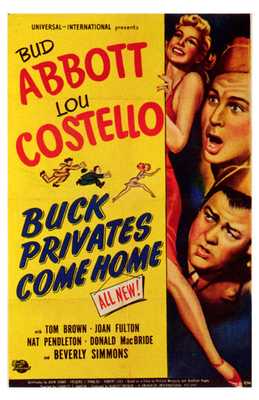
Buck Privates Come Home is a 1947 American comedy film directed by Charles Barton and starring the team of Abbott and Costello. It was released by Universal-International and is a sequel to their earlier film Buck Privates (1941).
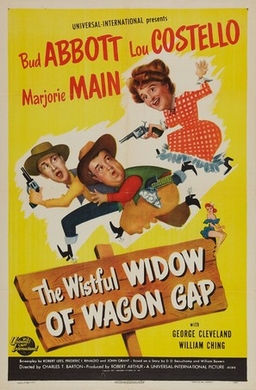
The Wistful Widow of Wagon Gap is a 1947 American comedy western film directed by Charles Barton and starring the comedy team of Abbott and Costello alongside Marjorie Main and Audrey Young. It was released on October 8 and distributed by Universal-International.

Abbott and Costello in the Foreign Legion is a black and white 1950 American comedy film directed by Charles Lamont and starring the comedy team of Abbott and Costello.
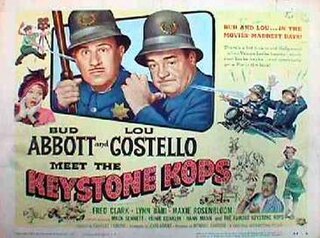
Abbott and Costello Meet the Keystone Kops is a 1955 comedy film directed by Charles Lamont and starring the comedy team of Abbott and Costello.
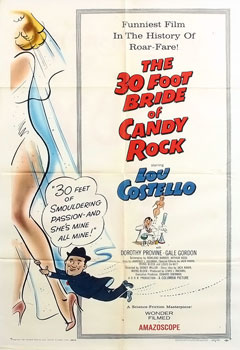
The 30 Foot Bride of Candy Rock is a 1959 American comedy science fiction film starring Lou Costello and Dorothy Provine and directed by Sidney Miller.
John Grant was a comedy writer best known for his association with Bud Abbott and Lou Costello. Costello called him their "chief idea man". Grant contributed to Abbott and Costello's radio, film and live television scripts, as well as the films of Dean Martin and Jerry Lewis and Ma and Pa Kettle.


















